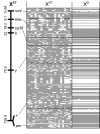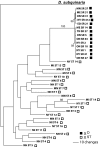Chromosome-wide linkage disequilibrium as a consequence of meiotic drive
- PMID: 17242362
- PMCID: PMC1785283
- DOI: 10.1073/pnas.0605578104
Chromosome-wide linkage disequilibrium as a consequence of meiotic drive
Abstract
Adaptation by natural selection proceeds most efficiently when alleles compete solely on the basis of their effects on the survival and reproduction of their carriers. A major condition for this is equal Mendelian segregation, but meiotic drive can short-circuit this process. The evolution of drive often involves multiple, interacting genetic components, together with enhancers and suppressors of drive. Chromosomal inversions that suppress crossing over are also frequently associated with drive systems. This study investigates the effects of these processes on patterns of molecular evolution in the fly Drosophila recens, which is polymorphic for a driving X chromosome (X(D)). Whereas standard wild-type chromosomes exhibit high levels of polymorphism at multiple loci, all of the X(D) chromosomes effectively carry a single multilocus haplotype that spans at least 130 cM. The X(D) is associated with a complex set of inversions that completely suppresses recombination between the standard wild-type chromosome and X(D) in heterozygous females, which maintain nonrandom associations among loci that presumably interact epistatically for the expression of drive. The long-term costs of foregoing recombination may be substantial; in combination with its low equilibrium frequency, this makes the X(D) chromosome susceptible to the accumulation of deleterious mutations. Consistent with this, X(D) chromosomes are apparently fixed for a recessive mutation that causes female sterility. Thus, the X(D) in D. recens appears to be in chromosome-wide linkage disequilibrium and in the early stages of mutational degradation.
Conflict of interest statement
The authors declare no conflict of interest.
Figures




References
-
- Crow JF. Sci Amer. 1979;240:134–143. - PubMed
-
- Lyttle TW. Trends Genet. 1993;9:205–210. - PubMed
-
- Fisher RA. The Genetical Theory of Natural Selection. Oxford: Oxford Univ Press; 1930.
-
- Hatcher MJ, Taneyhill DE, Dunn AM, Tofts C. Theor Popul Biol. 1999;56:11–18. - PubMed
-
- Prout T, Bundgaard J, Bryant S. Theor Popul Biol. 1973;4:446–465. - PubMed
Publication types
MeSH terms
Associated data
- Actions
- Actions
- Actions
- Actions
- Actions
- Actions
- Actions
- Actions
- Actions
- Actions
- Actions
- Actions
- Actions
- Actions
- Actions
- Actions
- Actions
- Actions
- Actions
- Actions
- Actions
- Actions
- Actions
- Actions
- Actions
- Actions
- Actions
- Actions
- Actions
- Actions
- Actions
- Actions
- Actions
- Actions
- Actions
- Actions
- Actions
- Actions
- Actions
- Actions
- Actions
- Actions
- Actions
- Actions
- Actions
- Actions
- Actions
- Actions
- Actions
- Actions
- Actions
- Actions
- Actions
- Actions
- Actions
- Actions
- Actions
- Actions
- Actions
- Actions
- Actions
- Actions
- Actions
- Actions
- Actions
- Actions
- Actions
- Actions
- Actions
- Actions
- Actions
- Actions
- Actions
- Actions
- Actions
- Actions
- Actions
- Actions
- Actions
- Actions
- Actions
- Actions
- Actions
- Actions
- Actions
- Actions
- Actions
- Actions
- Actions
- Actions
- Actions
- Actions
- Actions
- Actions
- Actions
- Actions
- Actions
- Actions
- Actions
- Actions
- Actions
- Actions
- Actions
- Actions
- Actions
- Actions
- Actions
- Actions
- Actions
- Actions
- Actions
- Actions
- Actions
- Actions
- Actions
- Actions
- Actions
- Actions
- Actions
- Actions
- Actions
- Actions
- Actions
- Actions
- Actions
- Actions
- Actions
- Actions
- Actions
- Actions
- Actions
- Actions
- Actions
- Actions
- Actions
- Actions
- Actions
- Actions
- Actions
- Actions
- Actions
- Actions
- Actions
- Actions
- Actions
- Actions
- Actions
- Actions
- Actions
- Actions
- Actions
- Actions
- Actions
- Actions
- Actions
- Actions
- Actions
- Actions
- Actions
- Actions
- Actions
- Actions
- Actions
- Actions
- Actions
- Actions
- Actions
- Actions
- Actions
- Actions
- Actions
- Actions
- Actions
- Actions
- Actions
- Actions
- Actions
- Actions
- Actions
- Actions
- Actions
- Actions
- Actions
- Actions
- Actions
- Actions
- Actions
- Actions
- Actions
- Actions
- Actions
- Actions
- Actions
- Actions
- Actions
- Actions
- Actions
- Actions
- Actions
- Actions
- Actions
- Actions
- Actions
- Actions
- Actions
- Actions
- Actions
- Actions
- Actions
- Actions
- Actions
- Actions
- Actions
- Actions
- Actions
- Actions
- Actions
- Actions
- Actions
- Actions
- Actions
- Actions
- Actions
- Actions
- Actions
- Actions
- Actions
- Actions
- Actions
- Actions
- Actions
- Actions
- Actions
- Actions
- Actions
- Actions
- Actions
- Actions
- Actions
- Actions
- Actions
- Actions
- Actions
- Actions
- Actions
- Actions
- Actions
- Actions
- Actions
- Actions
- Actions
- Actions
- Actions
- Actions
- Actions
- Actions
- Actions
LinkOut - more resources
Full Text Sources
Molecular Biology Databases

